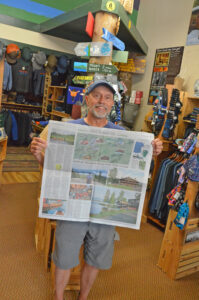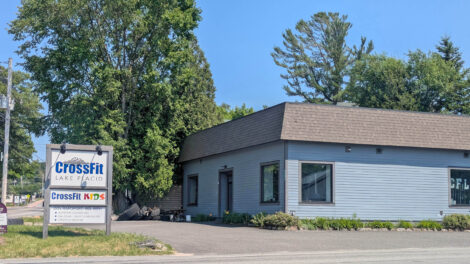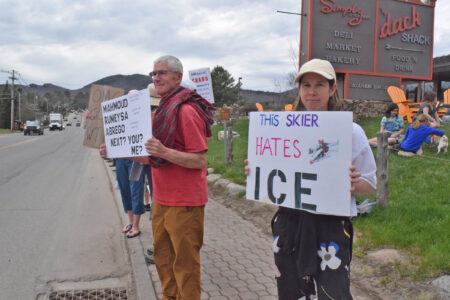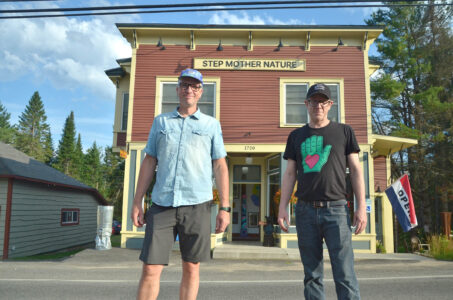Plan could allow driving almost to Boreas Ponds
No motors would be allowed on waters, but drivers could get closer
- New York state government officials and news reporters paddle on Boreas Ponds in September 2012. In the background is the Great Range — from left, Basin, Saddleback, Gothics and Pyramid — in the High Peaks Wilderness. (Enterprise photo — Mike Lynch)
- Boreas Ponds is seen from an airplane in September 2008. (Enterprise photo — Mike Lynch)

New York state government officials and news reporters paddle on Boreas Ponds in September 2012. In the background is the Great Range — from left, Basin, Saddleback, Gothics and Pyramid — in the High Peaks Wilderness. (Enterprise photo — Mike Lynch)
The state Adirondack Park Agency board is likely to vote on a proposed classification for the 20,000-acre Boreas Ponds Tract later this week, and while it could be months before the public knows the state’s specific plans for the property, the proposal recommended by APA staff offers some insights.
While the APA must issue land designations for Boreas, it is the state Department of Environmental Conservation’s responsibility to develop a unit management plan that will contain most of the management details, such as where trails, campsites and parking areas will be located and where motor vehicle access will be allowed.
“The Department [DEC], in consultation with the Agency, develops UMPs for the newly classified areas,” the APA’s Final Supplemental Environmental Impact Statement says. “Each UMP sets forth a statement of management objectives for the protection and rehabilitation of the area’s resources and ecosystems and for public use of the area consistent with its carrying capacity.”
In 2016, the APA released four possible classification schemes for Boreas. The plan recommended by agency staff — and set to be discussed this week — is a blending of plans 2 and 4, called Alternative 2B.
Alternative 2B uses two roads that already exist as a boundary line. Gulf Brook Road, which runs generally northwest from Blue Ridge Road to LaBier Flow, dead-ends at Boreas Ponds Road, which runs southwest and northeast.

Boreas Ponds is seen from an airplane in September 2008. (Enterprise photo — Mike Lynch)
Gulf Brook Road is entirely within wild forest in the plan, as is the southwestern portion of Boreas Ponds Road. The northwestern portion, which leads to the actual Boreas Ponds, would be designated as a narrow wild forest corridor.
“The 500-foot setback north of Gulf Brook and Boreas Ponds Roads would facilitate identical management practices on both sides of the roads which would limit possible confusion by users and allow for management consistency,” the Environmental Impact Statement says.
Keeping the existing roads as wild forest would let the DEC allow motor vehicle access all the way to the Boreas Ponds dam. The dam and a small area around it would be designated as primitive, one step down from wilderness. This area could also house a parking area if the DEC allows for one in its UMP.
“A 75-foot-wide Wild Forest corridor, which includes Boreas Ponds Road, would extend north of the Four Corners to and including an abandoned landing that could be used for parking,” according the Environmental Impact Statement. “The landing is approximately 50 by 75 feet (0.09 acre) in size and 590 feet (0.1 mile) from the Boreas Pond dam.”
Although motor vehicle access to the ponds is possible, the bulk of the shoreline and surrounding lands will become wilderness, which does not allow for snowmobiles, bicycles or other mechanized methods of transport. The waters of the ponds would also be wilderness, meaning no motorboats would be allowed.

The wild forest portion could allow mechanized recreation like snowmobiling and mountain biking.
“Alternative 2B proposes classification of 11,412 acres of the tract as Wilderness and another 11 acres as Primitive. Public recreational use of the Wilderness lands would be limited to non-motorized and non-mechanized uses, promoting a sense of remoteness preferred by many recreational visitors to the Adirondacks,” the Environmental Impact Statement says. “Alternative 2B provides resource protection through the classification of 9,118 acres of the Boreas Ponds Tract as Wild Forest, some of which may be suitable for motorized and/or mechanized recreational uses pursuant to the protections afforded by an approved UMP.”
To read the proposed classification in its entirety, including the four other proposals, go to www.apa.ny.gov/Mailing/2018/02/StateLand/SLMPFSEIS.pdf.
The APA board will meet this Thursday starting at 9 a.m. and Friday at 9:30. The meetings will be at APA headquarters in Ray Brook both days.







